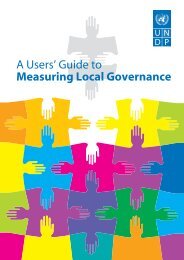English - UNDP
English - UNDP
English - UNDP
Create successful ePaper yourself
Turn your PDF publications into a flip-book with our unique Google optimized e-Paper software.
Tajikistan Project Assessment<br />
Figure 1 Administrative and territorial structure of the Republic of Tajikistan<br />
Republic of Tajikistan<br />
GORNO-<br />
BADAKHSHAN<br />
Autonomous Region<br />
7 districts and<br />
1 city<br />
KHATLON<br />
Region<br />
24 districts<br />
3 direct rule districts<br />
1 town of region rule<br />
SUGHD<br />
Region<br />
14 districts<br />
7 cities of region rule<br />
13 direct rule districts<br />
3 direct rule cities<br />
43 jamaots<br />
130 jamoats<br />
6 settlements<br />
20 urban type settlements<br />
113 jamoats<br />
91 jamaots<br />
3 settlements<br />
the village-level local administration is represented by a directly<br />
elected village jamoat.<br />
The way that local government functions is defined by the<br />
Constitution, the Law on Local Public Administration, and the<br />
Law on Local Self-Government in Villages and Towns.<br />
Local governments’ functions are categorized as their own<br />
(exclusive), delegated, joint, and those functions based on<br />
voluntary initiatives. Local governments have their own<br />
responsibilities and can propose initiatives, make decisions, and<br />
implement activities autonomously. Any issues not previously<br />
delegated to other authorities and involving local interests are<br />
referred to the local government. In addition, the Constitution<br />
grants local governments some authority to develop and<br />
implement their own budgets in coordination with national<br />
institutions, and to establish local fees, taxes, and duties. The<br />
Law on Local Public Administration allocates income tax to local<br />
budgets, to be utilized for the social needs of the territory in<br />
keeping with the Law on Social Insurance.<br />
The Constitution states that a jamoat is an institution of selfgovernment<br />
in towns and villages. The framework for their<br />
authority is set forth in the Law on Local Self-government in<br />
Towns and Villages 19 . Jamoats are formed on a territorial basis<br />
and possess legal status and an official seal. Town or village<br />
self-government revenue sources include budget allocations<br />
from city or regional councils, voluntary donations from citizens,<br />
and working collectives.<br />
The Law on Self-Activity and the Law on Public Association<br />
(kishlak – village organizations 20 ) regulate the workings of local<br />
self-government institutions 21 .<br />
Financing local government in Tajikistan<br />
Distribution of responsibilities between the central and local<br />
governments, and the procedure of planning and operating<br />
local budgets, are defined by the Constitution, the laws on<br />
Self-Government Bodies in Settlements and Villages, on State<br />
Finance, and annual Public Budget laws.<br />
Article 5 of the law on State Finance of the Republic of Tajikistan<br />
deals with local budgets: a) the budget of the Gorno-Badakhshan<br />
Autonomous Region and its cities and districts, b) the budgets<br />
of regions, cities and districts of regional rule, c) the budget<br />
of Dushanbe and its districts, d) the budgets of directly ruled<br />
cities and districts, and e) the budget of jamoats. However,<br />
financial autonomy in Tajikistan can be considered only at the<br />
level of regions, cities and districts. Therefore, jamoats do not<br />
have financial autonomy and their basic expenses are financed<br />
from city and district budgets 22 .<br />
18<br />
The Assembly has a right to carry out a vote of no-confidence in the head<br />
and other officials of local administration.<br />
19<br />
In this law, local self-governance is described as “the system of organizing<br />
public activities to address issues of local importance autonomously and at<br />
their own discretion, directly or indirectly, in accordance with the legislation of<br />
Republic of Tajikistan. Local self-governments resolve issues within their competence<br />
directly or through their representatives.”<br />
20<br />
The Constitutional Law “On Elections to Local Councils (Madjlis) of People’s<br />
Deputies” was proposed and adopted in December 1999 (effective as of 2000).<br />
It reflects the new political realities and enables participation of political parties<br />
and community organizations in the election process. In addition, this<br />
law stipulated that the establishment of no less than 70 single-seat electoral<br />
constituencies for the elections of Gorno-Badakhshan Autonomous region,<br />
regional and Dushanbe city councils, and no less than 40 single-seat electoral<br />
constituencies for elections of district and city councils.<br />
21<br />
Currently active are makhallia (community) committees, microraion councils,<br />
housing block committees or other kishlak (villages).<br />
22<br />
According to the amendment made in the law in 2009, jamoats can have<br />
their own budgets with effect from 2011. But the mechanism for implementation<br />
of this amendment has not yet been developed.<br />
13








![GuÃa del Usuario ] - Governance Assessment Portal](https://img.yumpu.com/44740603/1/190x253/gua-a-del-usuario-governance-assessment-portal.jpg?quality=85)








